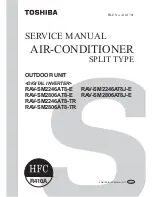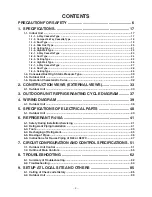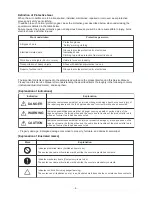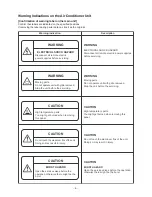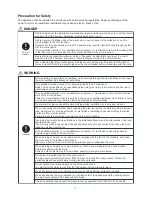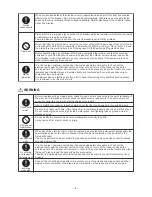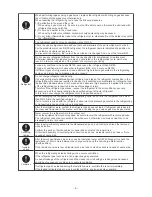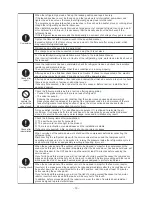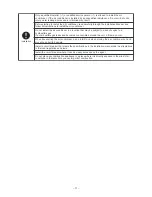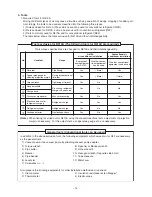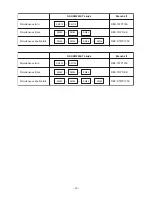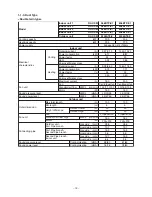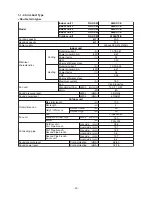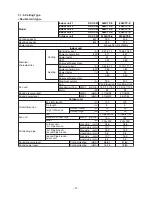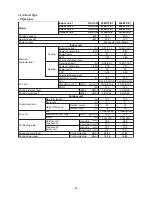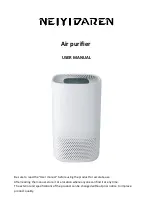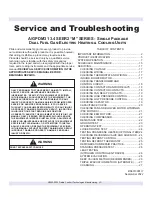
– 9 –
Refrigerant
Assembly/
Cabling
Insulator
check
Ventilation
The refrigerant used by this air conditioner is the R410A.
Check the used refrigerant name and use tools and materials of the parts which match with it.
For the products which use R410A refrigerant, the refrigerant name is indicated at a position on
the outdoor unit where is easy to see.
To prevent miss-charging, the route of the service port is changed from one of the former R22.
For an air conditioner which uses R410A, never use other refrigerant than R410A.
For an air conditioner which uses other refrigerant (R22, etc.), never use R410A.
If different types of refrigerant are mixed, abnormal high pressure generates in the refrigerating
cycle and an injury due to breakage may be caused.
Do not charge refrigerant additionally.
If charging refrigerant additionally when refrigerant gas leaks, the refrigerant composition in the
refrigerating cycle changes resulted in change of air conditioner characteristics or refrigerant over
the specified standard amount is charged and an abnormal high pressure is applied to the inside
of the refrigerating cycle resulted in cause of breakage or injury.
Therefore if the refrigerant gas leaks, recover the refrigerant in the air conditioner, execute
vacuuming, and then newly recharge the specified amount of liquid refrigerant.
In this time, never charge the refrigerant over the specified amount.
When recharging the refrigerant in the refrigerating cycle, do not mix the refrigerant or air other
than R410A into the specified refrigerant.
If air or others is mixed with the refrigerant, abnormal high pressure generates in the refrigerating
cycle resulted in cause of injury due to breakage.
After the installation work, confirm that refrigerant gas does not leak. If refrigerant gas leaks into
the room and flows near a fire source, such as a cooking range, noxious gas may be generated.
Never recover the refrigerant into the outdoor unit.
When the equipment is moved or repaired, be sure to recover the refrigerant with recovering device.
The refrigerant cannot be recovered in the outdoor unit; otherwise a serious accident such as
breakage or injury is caused.
Do not use any refrigerant different from the one specified for complement or replacement.
Otherwise, abnormally high pressure may be generated in the refrigeration cycle, which may
result in a failure or explosion of the product or an injury to your body.
After repair work, surely assemble the disassembled parts, and connect and lead the removed
wires as before.
Perform the work so that the cabinet or panel does not catch the inner wires.
If incorrect assembly or incorrect wire connection was done, a disaster such as a leak or fire is
caused at user’s side.
After the work has finished, be sure to use an insulation tester set (500V Megger) to check the
resistance is 1M
Ω
or more between the charge section and the non-charge metal section
(Earth position).
If the resistance value is low, a disaster such as a leak or electric shock is caused at user’s side.
When the refr
If refrigerant gas has leaked during the installation work, ventilate the room immediately.
If the leaked refrigerant gas comes in contact with fire, noxious gas may generate.
igerant gas leaks during work, execute ventilation.
If the refrigerant gas touches to a fire, poisonous gas generates.
A case of leakage of the refrigerant and the closed room full with gas is dangerous because a
shortage of oxygen occurs. Be sure to execute ventilation.
No fire
When performing repairs using a gas burner, replace the refrigerant with nitrogen gas because
the oil that coats the pipes may otherwise burn.
When repairing the refrigerating cycle, take the following measures.
1) Be attentive to fire around the cycle.
When using a gas stove, etc, be sure to put out fire before work; otherwise the oil mixed with
refrigerant gas may catch fire.
2) Do not use a welder in the closed room.
When using it without ventilation, carbon monoxide poisoning may be caused.
3) Do not bring inflammables close to the refrigerant cycle, otherwise fire of the welder may catch
the inflammables.

